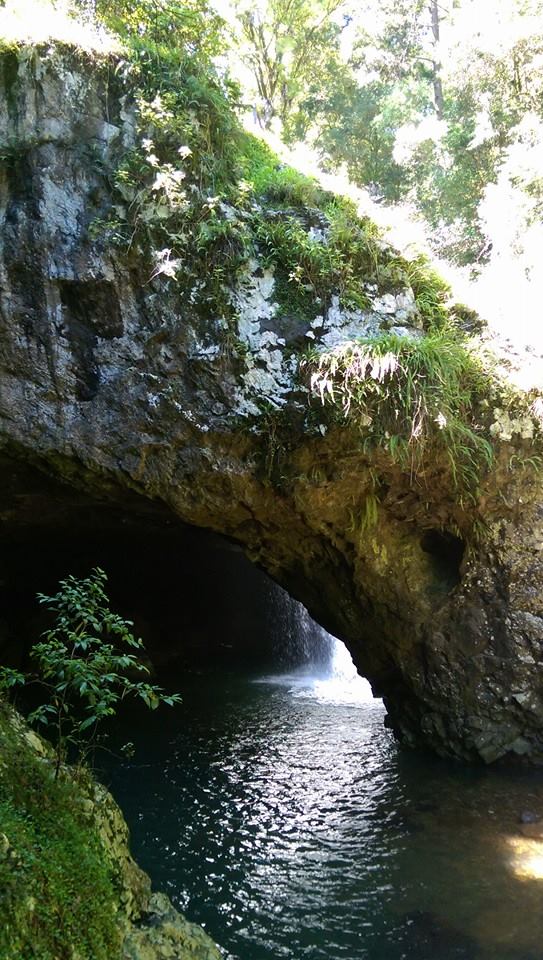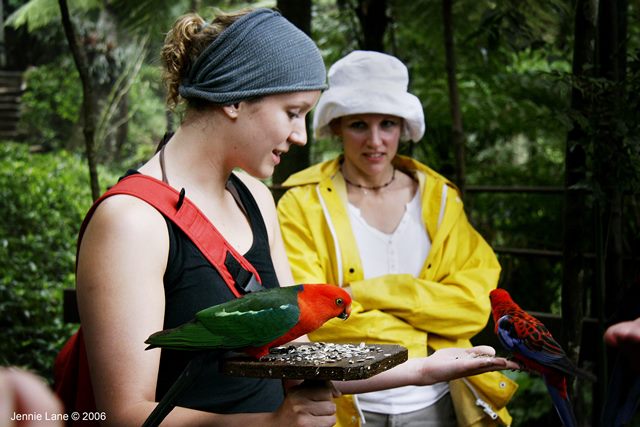
 ECO TOURISM - Small groups - Big Adventures
ECO TOURISM - Small groups - Big Adventures
Call Now 07 3880 2945 - AND PAY NO CREDIT CARD FEES!
tours@bushwacker-ecotours.com.au | Group Discounts | Download Brochure (pdf)
World Heritage
In 1994, Springbrook National Park was recognized by UNESCO Committee and officially declared the Gondwana Rainforests of Australia World Heritage Area over the Scenic Rim (including nearly all of Lamington National Park and Springbrook National Parks; and the rainforests of northern and central New South Wales. Including Mount Warning World Heritage)


World Heritage listing is a prestigious international recognition of the important conservation values of this special area, especially its unique geology, tropical and subtropical cool temperate rainforests. Springbrook National park also has a number of unique and rare flora and fauna. Springbrook National Park and Gondwana Rainforests of Australia World Heritage Area conserves a rich diversity of wildlife, including more than 1600 species of flowering plants and over 450 different animals. Protecting these areas in national parks or other reserves ensures this biological diversity is secure. It also allows natural processes such as evolution to continue, undisturbed by human influence. Join a Bushwacker tour today to learn more about these amazing
Gold coast hinterland locations. With pride, we protect and promote this world's heritage location. Help us ensure that while we enjoy this wonderful area, we do not destroy it. Please look then leave only footprints and take photos to last a lifetime.
Springbrook National Park plateau is the remnant of the northern side of a huge volcano. The volcano was built up of highly mobile basalt rock, and although centered on Mount Warning, it was about 80 km across. The volcano poured lava over 6000 km² .Mount Warning rim which has also perpendicular cliffs extending from Springbrook to Lamington plateau and the Tweed Range above the Mount Warning vent valley—is the largest and best of its age in the world. Visit Best of All lookout to view the grand scale of this magnificent lookout on a bushwacker eco tour today.
The Natural Bridge seen on all bushwacker eco tours is an example of the fresh water's power to shape and crave the hard basalt rock bridge we see today was once the lip of an old waterfall. At its base, softer, broken up basalt in a different flow was gradually eroded by swirling waters into an undercut cave. Rocks in the stream bed above swirled around to drill a pot-hole, which gradually deepened and broke through to the cave beneath. The creek fell into the cave and then enlarged it further. The lip of the old waterfall now forms a bridge, while the cave below has since eroded further back from the foot of the falls.
Flora and fauna at Springbrook National Park


The forests of Springbrook National Park can be grouped into 5 different types. On all bushwacker eco tours we pass through the many forests. These forest types are subtropical, warm temperate and cool temperate rainforests, open eucalypt forest and heath scrub. Subtropical rainforest, where we spend most of the day on walks and hikes, can be characterised by a closed canopy, vines, palms, epiphytes and large trees such as strangler figs, can be seen at Best of All Lookout, Natural Bridge and in the sheltered gorges of Springbrook. Bushwacker Eco Tour visits the cool temperate rainforest on the highest part of the plateau at Best of All lookout to view some of these ancient trees the Antarctic beech Nothofagus moorei — some are around 3000 years old. The two kinds of open eucalypt forest we see on Springbrook plateau and in the Numinbah Valley have a lot of Tall white-trunked flooded gums over palms and treeferns. In lower lying area of open mountain rangers we have a lot of Blue Mountains Ash, also banksia, casuarina and wattle. The New England blackbutt and silky oaks line the Rivers and Waterfalls in Numinbah section. Heath plants, including the golden banksia, red bottlebrush and purple hovea, can also be seen on these great day tour to the gold coast hinterland from Brisbane, Redcliffe and the Gold Coast.
Springbrook National Park has many mammals living in the quite natural surrounds. These include: pademelons (small rainforest wallabies / Kangaroo), brushtail possum and sugar glider. Koalas are occasionally seen on the drive down the mountain. Also more difficult to find are the spotted-tailed quoll, echidnas, bandicoots, reptiles and tree frogs. Over a hundred different bird species can be seen and heard in Springbrook National Park. The yellow-tailed black cockatoo, brown cuckoo-dove, lyrebird, yellow robin, crimson rosella, black and gold regent bower bird, midnight-blue satin bowerbird
History
Springbrook National Park's earliest human inhabitants were an Aboriginal group, the YugambehExternal link icon who lived in this area, carefully managing and using its rich natural resources. Known as 'kaban' (bush or rainforest) to the Yugambeh, the mountains are sacred and spiritual, places to be respected. 'Gurilahbu bungill'—'a long, long time ago' Jabreen was the creator of this land. He sent water to fall on the land and to give it life. It flowed towards the ocean, its energy changing as it went, flowing gently here, cascading there; nurturing the needs of all living things along the way. This place became the homeland of the Yugambeh people. 'Gulli Yugambehnga gaurema'—'this is the Yugambeh story' our ancestors have lived in this region for thousands of years. Scattered across the landscape are stone artefacts, rock shelters, rock art, scarred trees and earthen rings. They lived in a rich environment where water flowed in abundance. Natural resources were plentiful and families were self-sufficient in all seasons. The Yugambeh family groups were identified as the Wangerriburra, Birinburra, Gugingin, Migunberri, Mununjali, Bollongin, Minjungbal and Kombumerri. They shared language, ceremonies, celebrations and economic exchange. This kinship group used both the open forest and rainforest. Evidence of their occupation has been found throughout the park, including stone artefacts, rock shelters, rock art, scarred trees and earthen rings.
Stories demonstrate the Yugambeh's understanding and connection with their country. The landscapes held many stories that were passed down through the generations. The formation of the twin peaks of Mount Cougal — 'Ningeroongun' and 'Barrajanda' is an example. 'Gwyala', a great Yugambeh hunter of long ago, had two wonderful hunting dogs — 'Ningeroongun' and 'Barrajanda'. They were trained to chase kangaroos close in to the camp for capture.
One day, 'Gwyala' and his nephew 'Burrajum' entered the neighbouring Logan territory and the dogs caught a kangaroo rat. The dogs then saw and chased a kangaroo and were trying to run him towards 'Gwyala' and 'Burrajum'. The kangaroo jumped into a lagoon. Two girls, getting water from the lagoon, saw the hunting dogs' shadows and told their people who were camped not far away. All the men came over and succeeded in running the two dogs into a net. The dogs fought so fiercely that they were killed as the men endeavoured to secure them.
'Gwyala' and 'Burrajum' heard the commotion and ran towards the lagoon. When 'Gwyala' saw that 'Ningeroongun' and 'Barrajanda' were dead, he was terribly distressed and wept. 'Don't cry, Uncle,' said 'Burrajum'; 'I will cut a vine.' This is the rain-making ceremony. The people who had killed the dogs were much afraid. After 'Burrajum' had cut the vine, the clouds gathered and the rain commenced. Rain continued to fall heavily day after day; the creeks and rivers rose to torrents, great landslides scarred the mountains and buried all the people of the tribe.
When the skies cleared, the mountains had been reduced to little more than hills and ridges. In the meantime, 'Gwyala' and 'Burrajum' had taken the remains of 'Ningeroongun' and 'Barrajanda' over the big range to 'Wollumbin' (Mount Warning). There they buried the two dogs, one under each of the two little peaks east of 'Wollumbin'. Ever afterwards the two peaks were known as 'Ningeroongun' and 'Barrajanda'. This story warns those who seek to take away possessions of others. 'Nyah-nyah ngalingah kurul kaban'—'Take care of our wilderness.'
Springbrook plateau
The plateau's formidable terrain was the major obstacle to settlers and timber-getters claiming Springbrook. In 1865 Roberts and Rowland completed the survey of this extremely rough terrain, helped greatly by Bilin Bilin and other Yugambeh people in their party. Despite facing extreme conditions, Roberts made detailed field notes and named many landmarks, trees and animals using Aboriginal words from the Yugambeh language.

Springbrook was originally referred or known as amongst timber getters as the 'Land of the Tall Timber'. The first groups of selectors became collectively known as the Springwood Group. It is uncertain how they chose the name, a small creek that drained the central part of the plateau as Purling Brook and it seems likely they merely exchanged 'wood' for 'brook'. The name Springbrook came into common usage some time in 1907. Living on the plateau proved difficult. Better transport saw Springbrook become a popular tourist destination by the 1920s. The very obstacles that made life on the plateau difficult were the very things that attracted people—sheer cliffs, deep gorges and tumbling waterfalls. A guesthouse with dormitory-style accommodation, a post office and telephone exchange and a flourishing dairy industry were established and life improved on the plateau. By the 1940s seven guesthouses, three cafes and four different styles of self-contained accommodation were operating to cater for Springbrook's growing popularity. The current national park, covering 6190 ha. The Gondwana Rainforests of Australia World Heritage area, originally listed in 1986 to cover rainforests in New South Wales, was extended in 1994 to include rainforests on the Queensland side of the border. This property has an area of 366 507ha; 59 223ha is in Queensland. The Gondwana Rainforests of Australia World Heritage area meets three of the four natural criteria for listing:
- represents a major stage of the earth's evolutionary history
- is an outstanding example of ongoing ecological and biological processes.
- contains the most important natural habitats for conserving biological diversity.
An estimated 2 million people a year visit this World Heritage area. Book a trip with Bushwacker eco tours. Today, Lamington National Park has the largest remaining area of undisturbed subtropical rainforest. This property contains the world's most extensive subtropical rainforest and nearly all of the world's Antarctic beech cool temperate rainforest. Rainforests on both sides of the border contain more frog, snake, bird and marsupial species than anywhere else in Australia. This site provides a home for many rare and threatened plants and animals and ancient life forms. The New South Wales and Queensland Governments work together with tourism operators to protect this amazing National Park.